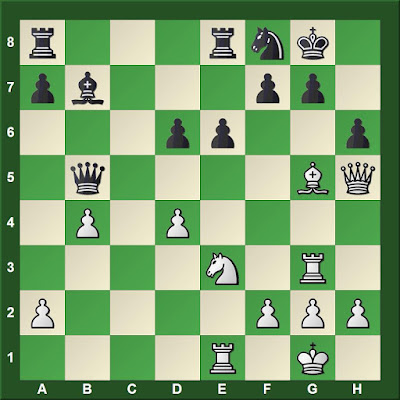For reasons that are not entirely clear, rooks on the seventh rank (or second) are sometimes called pigs or swine. The term "blind swine" or "blind pigs" has been attributed to Dawid Janowsky (1868-1927) and Rudolf Spielmann (1883-1942) by several writers, but the origins remain unknown.* Rooks on the rank occupied by the opponent's pawns can gobble everything. Two pigs, or one pig working with a bishop, can be a decisive pair. Sometimes they can save an otherwise lost game, as Janowsky showed on at least two occasions. Sometimes they can deliver checkmate or gobble enough pieces to produce a decisive material advantage.
My advanced students this week saw three positions. The first is from a game played by Janowsky against Jackson Showalter in 1898 (see Chess Notes 5160).
White to move
The checkmate threat was obvious to my students.
34.Rf1 Re8 35.Rff7 Ra6!
The point of Showalter's move here was less obvious to the young players. The point is that now 36.Rc7+ loses because the king will find shelter from checks on a8. Then, White will be helpless against Black's queenside pawns.
36.Rb7 a3 37.Rhc7+ Kd8 38.Rd7+ and White's rooks force a draw by repetition.
The second position was from one of my own blitz games this week.
White to move
Had my opponent played 35...g5 instead of 35...Nb5, I would have lost the game. Now, however, I have a clear and simple win.
36.Rxg7+ Kh8 37.Rgxf7+ Kg8 38.Rg7+ Kh8 39.Rh7+ Kg8 40.Rcg7#.
I call this checkmate pattern "two pigs" in my "Checklist of Checkmates". Some books call it the blind swine checkmate.
The third position is quite challenging until you have seen it once. The solution is the famous "windmill" that Carlos Torre used to defeat former World Champion Emanuel Lasker in 1925.
White to move
It was my knowledge of this famous combination that guided me in setting up one final desperate attempt in the game above. My opponent, on the other hand, did not recognize the threat.
25.Bf6!
This move is the only one leading to advantage, according to chess engines.
25...Qxh5 26.Rxg7+ Kh8 27.Rxf7+
A series of discovered attacks force Black's every move. The rook first clears the seventh rank of all but one pawn, then goes after the queen.
27...Kg8 28.Rg7+ Kh8 29.Rxb7+ Kg8 30.Rg7+ Kh8 31.Rg5+ Kh7 32.Rxh5 Kg6
With this fork, Lasker wins back some of the material.
33.Rh3 Kxf6 34.Rxh6+ Kg5 35.Rh3+ and White went on to win due to his three pawn advantage.
My beginning students received instruction in the elementary checkmate of queen and king against a lone king. I worked with students one at a time. Parents can learn the technique from "Teaching Elementary Checkmates".
*See Edward Winter, Chess Notes 7003, which cites Francis J. Wellmuth, The Golden Treasury of Chess (1943) attributing the term to Janowsky; and Chess Notes 6108, citing attribution to Spielmann in I.A. Horowitz and Geoffrey Mott-Smith, Point Count Chess (1960).
















I think there were dubbed 'blind pigs' by Nimzovitch in My System. Might come from somewhere else though ?!
ReplyDeleteI think the Torre-Lasker diagram is incorrect because with white to play, Nxd5 looks simpler. Maybe it's black move and after Q somewhere, white plays his famous combination
ReplyDeleteIt was incorrect, but is corrected now. Thanks. Black moved Qd5-b5.
Delete